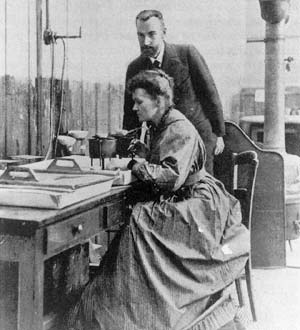

Take a look at the photo above. – only one woman. Was she respected? Not even close:
—–
“I believe that there is no connection between my scientific work and the facts of private life . . . I cannot accept the idea in principle that the appreciation of the value of scientific work should be influenced by libel and slander concerning private life.” Marie Curie, 1911 The biography of Marie Curie
Madame Curie would be honored a second time with sole recognition with a Nobel Prize for Chemistry in 1911, acknowledging her “discovery of the elements of radium and polonium, by the isolation of radium and the study of the nature and compounds of this remarkable element.”
Four years after the death of her husband and research partner Pierre in 1910 from a freak street accident, Madame Curie began a relationship with physicist Paul Langevin, a former student of Pierre’s. Perhaps not the best choice for a companion, Langevin was married, although many suggest he was rarely faithful. Still, Curie was lonely and went so far as to send a letter to Langevin suggesting a separation from his wife. Unfortunately for her, his wife’s brother was editor of a newspaper and she decided to blackmail Curie, threatening her reputation and hoping to subject her to public hatred. Although she paid, the letters were eventually published after her prize was announced and were fodder for the jealous scientific community over her second Nobel Prize in 1911. In fact, she was harassed at her home and office once the letters were made public, leading the prize committee to withdraw her invitation to the ceremony.
She went anyway. Soon after, Langevin and his wife divorced, but the affair never resumed. Ironically, today, Curie’s granddaughter and Langevin’s grandson are married today.
In 1903, Madame Curie was honored with her first Nobel Prize in Physics, shared by her husband Pierre and French Physicist Henri Becquerel, “in recognition of the extraordinary services they have rendered by their joint researches on the radiation phenomena discovered by Professor Henri Becquerel.”
Nine years earlier, Curie, then Marie Skodowska was denied a place at Krakow University because she was a woman.
Not only was she the first woman to receive the Nobel Prize for Physics, it was shared by she and two men, although it was she who began studying uranium rays using the Curie electrometer, her technique was individual and resulted in her finding the radiation was not the outcome of molecule interactions, instead it came from the atom. Around 1898 Pierre, became so excited by her work, he abandoned his study on crystals.
Author of Marie Curie, Robert Reid writes, “The idea was her own; no one helped her formulate it, and although she took it to her husband for his opinion, she clearly established her ownership of it. She later recorded the fact twice in her biography of her husband to ensure there was not chance whatever of any ambiguity.”
Even with all her achievements including the Nobel Prize for Physics, chair of the physics laboratory at the Sorbonne, a doctorate in science and professor of general physics in the Faculty of Sciences, she was denied membership in 1911 to the male-only French Academy of Sciences. Later that year, she would be award her second Nobel Prize in Chemistry.
It would take another 50 years, in 1962, for the Academy to accept its first woman – Madame Curie’s doctoral student, Margerite Perey. The Curie’s daughter, Irene Joliot-Curie and her husband Frederic Joliot-Curie also received a Nobel Prize in Chemistry in 1935 for their discover of artificial radioactivity…AND the Curie’s grandchildren Helen Langevin-Joliot (she married the grandson of Curie’s lover Paul Langevin) is a nuclear physicist and her brother Pierre Joliot is a biochemist.


